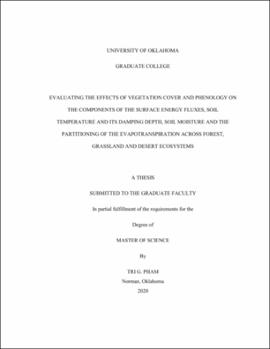| dc.description.abstract | The understanding and modeling of the effects of land-cover change on the behaviors of evapotranspiration flux and its partitioning, soil moisture, soil temperature, and surface energy fluxes which include ground heat flux, sensible heat flux, and latent heat flux (evapotranspiration) is an active research field with applications to hydrologic engineering. Knowledge of these shifts could improve our estimations of precipitation, heat waves, drought mechanisms, soil moisture and flood forecasting. This study utilized long-term eddy covariance measurements and remote sensing data to investigate the effects of both vegetation cover disturbance and vegetation phenology on key hydrologic variables at seven research sites in Oklahoma and Arizona. The study focused on: (1) the use of eddy covariance measurements and remote sensing data for comparison of surface energy fluxes, soil moisture, and soil temperatures, (2) the calibration and validation of the TIN-based Real-time Integrated Basin Simulator (tRIBS) hydrological model to simulate surface energy and water balance variables and to assess its ability to predict short- and long-term time series at hourly time steps, (3) the partitioning of the evapotranspiration into three components: transpiration from vegetation, wet canopy evaporation from intercepted precipitation on leaves and soil evaporation and the identification of the roles of vegetation and precipitation on the partitioning, (4) the calculation of the daily temperature damping depths at the research sites quantification of roles of vegetation and soil moisture and, (5) the development of a toolkit to automate and visualize tRIBS simulations and reduce human errors.
This study found that:
(1) tRIBS demonstrated its capability to conduct footprint type of simulations at an hourly time step by using process-based conceptualizations and remote sensing with high correlation and Nash-Sutcliffe model efficiency coefficients between simulations and observations. The model also captured the diurnal variability of the simulated variables, which potentially can be used to fill the gap in the missing eddy covariance measurements.
(2) Across simulations sites, responses of simulated ground heat flux, sensible heat flux, and soil temperatures depended on soil heat conductivity and heat capacity parameters. Additionally, latent heat flux seemed to depend on both soil thermal properties but also on the stress thresholds for transpiration and evaporation, in addition to the hydraulic conductivity, air entry bubbling pressure, and pore distribution index. Soil moisture was more complex and sensitive to the saturated hydraulic conductivity and stress threshold.
(3) In arid environments (i.e. Santa Rita, AZ), differences in vegetation cover represented differences in the distribution of the surface energy balance components. For example, latent heat flux was always higher for grassland than creosote or mesquite cover. Also, at the grassland location, both sensible heat flux and soil temperature were lower due to higher ground coverage percentage. Ground heat flux was similar between the three cover types with slightly higher rates from March to June at the herbaceous cover and lower rates at the mesquite site. For soil moisture, mesquite experienced the lowest average values both at near surface and deeper soil layers.
(4) In forested sites, thinning of tall vegetation due prescribed fire (i.e. Flagstaff, AZ) reduced the amount of latent heat flux, sensible heat flux and the total net radiation while increased the ground heat flux and soil temperature which led to reductions in soil moisture. The severity of the thinning was the main indicator on the subsequent responses of the surface-energy fluxes, soil moisture, and soil temperature.
(5) The damping depth in forest ecosystem and desert ecosystem exhibited seasonal variations and the partitioning of evapotranspiration showed the highest contribution came from soil evaporation for both ecosystems. Furthermore, the partitioning of evapotranspiration from the simulation outputs and the high agreement with actual sap flow measurements at US-SRC showed its potential to be used in future study to estimate the partitioning of ET without the need for expensive equipment and fieldwork.
(6) VisualtRIBS was developed to visualize the spatial outputs of the simulations and a collection of scripts were compiled into in R language to process MODIS satellite data and set up the tRIBS simulation folder. The calibration was also improved to simultaneously calibrate 26 parameters.
Results from this study can be used for providing new insights into the physics that drive the shifts in the land-atmosphere interactions due to vegetation phenology and abrupt changes in the land cover. All outcomes of this research will assist the U.S. Army Research Office through conceptualizations on the shifts in the land surface conditions for decision making on deployment and terrain operability as well as the Oklahoma Water Survey in assessing the relationship between vegetation and hydrologic cycle components. | en_US |
